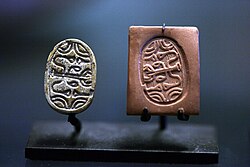This article includes a list of general references, but it lacks sufficient corresponding inline citations .(December 2011) |

The stamp seal (also impression seal) is a common seal die, frequently carved from stone, known at least since the 6th millennium BC (Halaf culture [1] ) and probably earlier. The dies were used to impress their picture or inscription into soft, prepared clay and sometimes in sealing wax.
Contents
The oldest stamp seals were button-shaped objects with primitive ornamental forms chiseled onto them. [2] The stamp seals were replaced in the 4th millennium BC by cylinder seals that had to be rolled over the soft clay to leave an imprint. [1] From the 12th century BC the previous designs were largely abandoned in favor of amphora stamps. [3] Romans introduced their signaculum around the first century BC; [3] Byzantine maintained the tradition in their commercial stamps. [4]
In antiquity the stamp seals were common, largely because they served to authenticate legal documents, such as tax receipts, contracts, wills and decrees.




